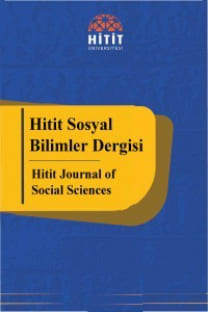KENTLİ YOKSULLARIN KONUT SORUNUNA YÖNELİK PROAKTİF BİR ÇÖZÜM ÖNERİSİ: ARTIMLI KONUT MODELİ
Günümüzde küresel kentsel nüfus, kırsal nüfusu geçmiştir. Artan kentli nüfusla birlikte yoksulluk sorunsalı da kentlerde kendini daha fazla hissettirir olmuştur. Bununla eş zamanlı olarak, kentli yoksulların konut sorunu içinden çıkılmaz bir hal almıştır. Devletlerin yoksullar için ürettikleri anahtar teslimi konutlar ise kentli yoksulların konut sorununun çözümünde yetersiz kalmaktadır. 2016 Pritzker ödülünün sahibi Alejandro Aravena tarafından geliştirilen artımlı konut projeleri, kentli yoksulların konut sorununun çözümünde etkili bir alternatifi oluşturmaktadır. Bu çalışma ile dünyanın farklı yerlerinde üretilen artımlı konut modelleri üzerinde durulmuştur. Ülkemizdeki kentli yoksulların konut sorunlarının çözümü için önerilen bu yöntemin, aynı zamanda gecekondu bölgelerinde yaşayan yoksulların sosyo-ekonomik ve psikolojik sorunlarını da azaltması beklenmektedir.
Anahtar Kelimeler:
Kentsel Yoksulluk, Artımlı Konutlar, Gecekondu, KentseL Dönüşüm
___
- ABRAMS, Charles (1964), Housing in the Modern World. London: Faber and Faber, s. 175
- AHSAN, R. ve J.M. Quamruzzaman (2009), “Informal Housing and Ap-proaches Towards the Low-income Soci¬ety in Developing Countries”, Paper pre¬sented at the Australian Sociological Association Annual Conference Aus¬tralian National University, Canberra, Australia.
- AKTAN, Coşkun Can (2002), Yoksullukla Mücadele Stratejileri, Hak İşçi Sendikaları Konfederasyonu Yayınları, Ankara.
- ALTAN, Ömer Zühtü (2004), Sosyal Politika, Anadolu Üniversitesi, Açıköğretim Fakültesi Yayınları, Eskişehir.
- ARAVENA, A. (2013), Elemental: Incrementral Housing and Participatory Design Manual. Ostfildern: Bilingual.
- ARSLAN Adile, (1998), Türkiye'de Yeni Kentli Yoksulluk Biçiminden Bir Kesit: Van'daki Dere Kenarları Van Dosyası, Teknolojik Afet, Zorunlu Göç, TMMOB. Mimarlar Odası Yayınları, Ankara.
- AYTAÇ, Ömer ve İlhan Oğuz AKDEMİR (2002), Türkiye'de Kentli Yoksulluk Sorunu, TODAIE, İnsan Haklan Araştırma ve Derleme Merkezi Yayını, Ankara.
- BEARDSLEY, J. (2007), “A Billion Slum Dwellers and Counting”, Harvard Design Magazine, no: 27.
- COHEN, M. A. (1983), The Challenge of Replicability: Towards a New Paradigm for Urban Shelter in Developing Countries. Regional Development Dialogue, 4(1), ss. 90–99.
- DONNİSON, D (1993), Agenda for the future. Campell McConnell (der.) Trickle Down on Bubble Up? London: Community Development Foundation.
- GAO/NSIAD, (1986), The Solanda Housing Guaranty Project in Ecuador.
- GARCÍA-HUİDOBRO, F., D. TORRES TORRİTİ ve TUGAS, N., (2003). El Tiempo Construye. Time Builds, Barcelona.
- GREENE, M. ve E. ROJAS (2008), “Incre¬mental Construction: A Strategy to Facilitate Access to Housing. Environ¬ment and Urbanization Journal, 20, ss. 89- 108.
- GÜRSEL, Seyfettin, Haluk LEVENT, Raziye SELİM ve Özlem SARICAN (2000), Türkiye'de Bireysel Gelir Dağılımı ve Yoksulluk Avrupa Birliği İle Karşılaştırma, TÜSİAD yayınlan, İstanbul.
- HARPER Caleb, Vasco PORTUGAL and Layla SHAIKLEY (2012) High-Density Incremental Expansion Un-Habıtat world urban forum training session 2012, Un-Habitat World Urban Forum.
- IHC (International Housing Coalition) (2008), Multilateral and Bilateral Funding for Housing and Slum Upgrading Development in Developing Countries. Washington, D.C.
- KELEŞ, R. (2004), “Kentsel Dönüşümün Tüzel Altyapısı”, Editör: H. B. Tuna. Dosya: Kentsel Dönüşüm ve Katılım, Mimarist Dergisi,
- TMMOB Mimarlar Odası İstanbul Büyükkent Şubesi, 4(12), ss. 73-75.
- LICHFIELD, D. (1992), Urban Regeneration for the 1990s. London: London Planning Advisory Committee.
- LAND, Peter (2015), The Experimental Housing Project (PREVI), Lima: Design and Technology in a New Neighborhood, Universidad de Los Andes.
- NEVES, Sofia Ornelas ve Miguel AMADO (2014), Incremental Housing as a method to the Sustainable Habitat, INTERNATIONAL PLEA CONFERENCE 16-18 December 2014, CEPT University, Ahmedabad.
- NEVES, S. O. (2013). Redesenhar e requalificar o lugar informal – Do Bairro à Cidade. Lisboa: FA, UL. PORTAS, N. ve F.S. DİAS (1972). “Habitação Evolutiva”, Revista Arquitectura: Planeamento, Design, Artes Plásticas, no:126, ss. 100-121.
- ROBERTS, P. (2000), “The Evolution, Definition and Purpose Of Urban Regeneration” Peter Roberts ve Hugh Sykes (der.) Urban Regeneration. London, Thousand Oaks, New Delhi: Sage Publications. ss. 9-36.
- ROJAS, E. ve F. MAGALHAES( 2007), Facing the Challenges of İnformal Settlements in Urban Centres: The Re-Urbanization of Manaus, Brazil. In Brazil, edited by Inter-American.
- RTI International (2005), LAC Housing and Urban Upgrading Assistance Retrospective.
- THOMAS, S. (2003), A Glossary of Regeneration and Local Economic Development, Manchester: Local Economic Strategy Center.
- TSENKOVA, S. (2009), Housing Policy Reforms in Post Socialist Europe, Vi¬enna Declaration on National Regional Policy and Programmes 2004 on In¬formal Settlements. Retrieved from: http://www.springerlink.com/content/ mg02753733513471/fulltext.pdf. URL1 https://www.slideshare.net/khushboosood/aranya-community-housing
- URL 2 https://www.slideshare.net/khushboosood/aranya-community-housing
- URL3a http://densityatlas.org/casestudies/profile.php?id=157
- URL3b https://archnet.org/system/publications/contents/7083/original/DPC3959.pdf?1384808046
- URL 4 http://www.grahamfoundation.org/grantees/4838-the-experimental-housing-project-previ-lima-design-and-technology-in-a-new-neighborhood
- URL 5 http://web.mit.edu/incrementalhousing/articlesPhotographs/
- USAID, Innovation in Urban Development: Incremental Housing, Big Data and Gender, Edited by Allison M. Garland, s. 1.
- WAKELY, P. ve E. RİLEY (2011). “Cities Without Slums: The Case for Incremental Housing”, Cities Alliance Policy Research and Working Papers Series, No.1. Washington, USA.
- WAINER Laura Sara, Billy Ndengeingoma ve Sally Murray, Incremental Housing, and Other Design Principles for Low-Cost Housing, Final Report, IGC, 2016, C-38400-RWA-1.
- WILLIAMS, S. M. (2005), Young Town Growing Up (Y.L. Tezi), Depart-ment of Urban Studies and Planning and the Department of Architecture Massachusetts Institute of Technology, Massachusetts.
- Yayın Aralığı: Yılda 2 Sayı
- Başlangıç: 2008
- Yayıncı: Hitit Üniversitesi
Sayıdaki Diğer Makaleler
KALKINMA VE DEVLET ALGISI: ÇORUM ÖRNEĞİ
OKULUM VE ÖĞRETMENİM HAKKINDA NE DÜŞÜNÜYORUM?
Ayşe ÖZTÜRK SAMUR, Gözde İNAL KIZILTEPE
ÖRGÜTLERDE İNSAN ENERJİSİ: TEORİK ÇERÇEVE
OTEL ÇALIŞANLARININ PSİKOLOJİK GÜÇLENDİRME İLE ÖRGÜTSEL BAĞLILIKLARI ARASINDAKİ İLİŞKİ
‘DURUMSAL MUHAFAZAKÂRLIK’ ANLAYIŞI ÜZERİNE TEORİK & ELEŞTİREL BİR DEĞERLENDİRME
EDEBİYAT VE KÜLTÜR: BİREYSEL VE TOPLUMSAL GELİŞMEDE OKUMA VE KÜTÜPHANE ALIŞKANLIĞI ÜZERİNE
Cumhur GÜNKÖR, Cennet GÖLOĞLU DEMİR
TÜRK İMALAT SANAYİİNİN ENDÜSTRİ-İÇİ TİCARETİ (2001-2014)
Osman Barbaros KEMER, Muhammed Fatih AYDEMİR
SPOT VE VADELİ PİYASALAR ARASINDA RİSK DURUMUNDA NEDENSELLİK İLİŞKİSİ
